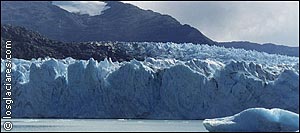|
|
|
|
 
|
Los Glaciares National
Park
Welcome
|
|
 |
 |
  Los
Glaciares National Park is located in the
area known as Austral Andes in Argentina, in the
south west of Santa Cruz on the border with Chile.
By his magnificent natural beauty, it constitutes
a wonder in the world, and was declared "World
Heritage" by UNESCO in 1981. Los
Glaciares National Park is located in the
area known as Austral Andes in Argentina, in the
south west of Santa Cruz on the border with Chile.
By his magnificent natural beauty, it constitutes
a wonder in the world, and was declared "World
Heritage" by UNESCO in 1981. |
|


Upsala glacier - Los Glaciares National Park |

  The
information given in this section has been thoroughly
selected by the National Park team. It is remarkable
the effort done to gather precise information about
flora, fauna and geology of this area, since the bibliography
on this subject is very rare, and working on the area
is extremely expensive and titanic considering the extension
and biodiversity of this National Park. The
information given in this section has been thoroughly
selected by the National Park team. It is remarkable
the effort done to gather precise information about
flora, fauna and geology of this area, since the bibliography
on this subject is very rare, and working on the area
is extremely expensive and titanic considering the extension
and biodiversity of this National Park.

|
 |
| General aspects |
 |
This
park shows a scenario of mountains, lakes and
woods, including a large portion of the Andes
practically under ice and snow to the west,
and the arid Patagonian steppe to the east.

Its name refer to the glaciers that are born
on the Ice Caps - the largest continental ice
extension after Anctartica- which occupies almost
half its area. Also known as Patagonic Continental
Ice, creates 47 big glaciers, 13 of which flow
to the Atlantic. There are also more than 200
smaller glaciers, unconnected to the Ice Caps. |
| 

Los
Glaciares National Park map |
 |
Los
Glaciares National Park is located in the area
known as Austral Andes in Argentina, in the
south west of Santa Cruz on the border with
Chile.

All over the world glaciers are over 2500 mts
over sea level, but here, in Santa Cruz, they
are originated on the Ice Caps, at 1500 mts
over sea level, and flow down to 200 mts, having
the possibility of an unique approach and view.

As a result of the enormous pressure of the
antique ice and the subsequent thaw, three big
lakes, two of them inside the NP appeared:
Lago Argentino and Lago Viedma,
the waters of which flow as Rio Santa Cruz
to the Atlantic Ocean crossing the province. |
|
 |
  Up Up |
 |
| Tourist Activities |
 |
| Nowadays,
the Park welcomes a great number of tourists from all
around the world, offering multiple choices to visit
it almost all the year round. |
 |
| Glaciar
Perito Moreno |
 |
| On
the southern area of the Park, the most famous
glacier can be seen: Perito Moreno. It is very
famous because of its dynamic changes, which
produces a cyclic phemomenon of forward and
backward movement, with spectacular ice falls
from its front walls. The closest town is
El Calafate, center of all the activities
and services. |
 |
 |
 |
 |
 |
| Monte
Fitz Roy |
 |
| On
the northern extreme of the park, the granite
peaks, lakes, woods and glaciers become all
together one of the most extraordinary places
of the world. The highest mountains are Mt.
Fitz Roy (3405m) and Mt. Torre (3102 m). In
this scenario, the small village of
El ChaltÚn, gives shelter to the climbers
and trekkers of all around the world. |
|
 |
 |
 |
 |
  Up Up |
 |
| Flora
& Fauna |
 |
Flora

Flora of the patagonic Andes is mainly composed
of lenga, el ˝ire y el guindo (Nothofagus sp.)

 |
|
 |
 |
Fauna

National Park┤s Fauna has species from
sub anctartic woods and the steppe. Condor,
Aguila mora, choique, guanaco, puma (Felis concolor)
are representative from this area.

 |
|
 |
 |
  Up Up |
|
 |
| How to get there |
 |
|
 |
  Up Up |
|  |
|
|